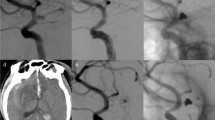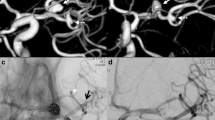Abstract
Background
Parent artery occlusion for intractable aneurysms or sinus packing for dural arteriovenous fistulas (DAVFs) is sometimes difficult and requires many expensive coils to accomplish complete occlusion. To help solve these problems, we reviewed our experience using 0.035-inch coil (0.035 coil; Boston Scientific, San Leandro, CA, USA), which has been used in cardiovascular and abdominal lesions.
Methods
These 0.035 coils were preferably used in addition to the detachable and fibered coils for patients with intractable aneurysms, traumatic vessel blowout, and DAVF. Our strategy was as follows: (1) detachable coils were deployed first for the ideal anchoring of the coils; (2) small fibered coils were additionally deployed to stabilize the coil mass; (3) 0.035 coils were deployed to complete the occlusion.
Results
From January 2012 to December 2013, seven consecutive patients were treated by endovascular embolization with 0.035 coils. Reasons for intervention were parent artery occlusion for carotid blowout (n = 1), internal carotid artery aneurysm (n = 2), traumatic vertebral artery injury (n = 2), vertebral AVF (n = 1), and transverse sinus-sigmoid sinus DAVF (n = 1). In our cases, a mean of 20.1 ± 8.5 coils per vessel were placed, and mean total coil length was 258.4 ± 91.5 cm per vessel. All procedures were safely performed and complete occlusions achieved.
Conclusions
From our initial experience and treatment results, we believe endovascular parent artery occlusion or sinus packing with 0.035 coils to be useful in terms of reducing the number and expense of coils and also accomplishing immediate occlusion.



Similar content being viewed by others
References
Barr JD, Lemley TJ (1999) Endovascular arterial occlusion accomplished using microcoils deployed with and without proximal flow arrest: results in 19 patients. AJNR Am J Neuroradiol 20:1452–1456
Beaty NB, Jindal G, Gandhi D (2015) Micro Vascular Plug (MVP)-assisted vessel occlusion in neurovascular pathologies: technical results and initial clinical experience. J Neurointervention Surg 7:758–761
Bendszus M, Solymosi L (2006) Cerecyte coils in the treatment of intracranial aneurysms: a preliminary clinical study. AJNR Am J Neuroradiol 27:2053–2057
Clarencon F, Bonneville F, Boch AL, Lejean L, Biondi A (2011) Parent artery occlusion is not obsolete in giant aneurysms of the ICA. experience with very-long-term follow-up. Neuroradiology 53:973–982
Daugherty WP, Kallmes DF, Cloft HJ, Lanzino GL (2010) MicroNester coils as an adjunct to endovascular embolization. World Neurosurg 73:390–394
Dinkel HP, Triller J (2002) Pulmonary arteriovenous malformations: embolotherapy with superselective coaxial catheter placement and filling of venous sac with Guglielmi detachable coils. Radiology 223:709–714
Dudeck O, Bulla K, Wieners G, Ruehl R, Ulrich G, Amthauer H, Ricke J, Pech M (2011) Embolization of the gastroduodenal artery before selective internal radiotherapy: a prospectively randomized trial comparing standard pushable coils with fibered interlock detachable coils. Cardiovasc Intervent Radiol 34:74–80
Fukuda S, Hayashi K, Yamaguchi S, Horie N, Morikawa M, Suyama K, Nagata I (2014) [Carotid blowout syndrome treated by parent artery occlusion using pushable coils: a case report]. No shinkei geka. Neurol Surg 42:615–620
Graves VB, Perl J 2nd, Strother CM, Wallace RC, Kesava PP, Masaryk TJ (1997) Endovascular occlusion of the carotid or vertebral artery with temporary proximal flow arrest and microcoils: clinical results. AJNR Am J Neuroradiol 18:1201–1206
Guglielmi G, Vinuela F, Sepetka I, Macellari V (1991) Electrothrombosis of saccular aneurysms via endovascular approach. Part 1: Electrochemical basis, technique, and experimental results. J Neurosurg 75:1–7
Halbach VV, Dowd CF, Higashida RT, Balousek PA, Urwin RW (1998) Preliminary experience with an electrolytically detachable fibered coil. AJNR Am J Neuroradiol 19:773–777
Hayashi K, Horie N, Morikawa M, Nagata I (2014) Usefulness of C-stopper coil for neurointervention. Neurologia Medico-Chirurgica
Hayashi K, Kitagawa N, Morikawa M, Hiu T, Morofuji Y, Suyama K, Nagata I (2009) MicroNester coil for neurointervention. J Neurosurg 110:40–43
Hayashi S, Baba Y, Senokuchi T, Nakajo M (2012) Efficacy of venous sac embolization for pulmonary arteriovenous malformations: comparison with feeding artery embolization. J Vascular Intervention Radiol: JVIR 23:1566–1577, quiz p 1581
Huang TC, Hsieh KS, Lee CL, Lin CC (2002) Safety and efficacy of using 0.052-inch Gianturco coil for closure of large (> or = 4mm) patent ductus arteriosus. J Invasive Cardiol 14:173–177
Inoue M, Tanaka T, Nakagawa H, Yoshioka T, Kichikawa K (2013) Splenic vein embolization using coil anchors and prophylactic occlusion of a hepatofugal collateral for hepatic encephalopathy due to splenorenal shunt: technical note and literature review. Case Rep Radiol 2013:160653
Ishiguro T, Komiyama M, Yamamoto N, Kunihiro N, Nakamura K, Yoshimura M, Oishi K (2009) Carotid blowout syndrome treated by internal trapping using 0.035-inch non-detachable fibered coils:case report. J Neuroendovasc Therapy 3:198–202
Kallmes DF, Cloft HJ (2004) The use of hydrocoil for parent artery occlusion. AJNR Am J Neuroradiol 25:1409–1410
Kallmes DF, Fujiwara NH (2002) New expandable hydrogel-platinum coil hybrid device for aneurysm embolization. AJNR Am J Neuroradiol 23:1580–1588
Labeyrie MA, Lenck S, Bresson D, Desilles JP, Bisdorff A, Saint-Maurice JP, Houdart E (2015) Parent artery occlusion in large, giant, or fusiform aneurysms of the carotid siphon: clinical and imaging results. AJNR Am J Neuroradiol 36:140–145
Liebig T, Henkes H, Fischer S, Weber W, Miloslavski E, Mariushi W, Brew S, Kuhne D (2004) Fibered electrolytically detachable platinum coils used for the endovascular treatment of intracranial aneurysms. Initial experiences and mid-term results in 474 aneurysms. Intervention Neuroradiol: J Peritherapeut Neuroradiol, Surg Proc Relat Neurosci 10:5–26
Maleux G, Willems E, Vaninbroukx J, Nevelsteen A, Heye S (2010) Outcome of proximal internal iliac artery coil embolization prior to stent-graft extension in patients previously treated by endovascular aortic repair. J Vasc Intervention Radiol: JVIR 21:990–994
Mascitelli JR, Polykarpou MF, Patel AA, Kamath AA, Moyle H, Patel AB (2013) Initial experience with Penumbra Coil 400 versus standard coils in embolization of cerebral aneurysms: a retrospective review. J Neurointervention Surg 5:573–576
Milburn J, Pansara AL, Vidal G, Martinez RC (2013) Initial experience using the Penumbra coil 400: comparison of aneurysm packing, cost effectiveness, and coil efficiency. J Neurointervention Surg
Nogi S, Haneda N, Tomita H, Yasuda K (2008) Transcatheter coil occlusion of perimembranous ventricular septal defects. Catheter Cardiovasc Intervention: Off J Soc Cardiac Angiography Intervention 72:683–690
Owada CY, Teitel DF, Moore P (1997) Evaluation of Gianturco coils for closure of large (> or = 3.5 mm) patent ductus arteriosus. J Am Coll Cardiol 30:1856–1862
Pellerin O, Maleux G, Dean C, Pernot S, Golzarian J, Sapoval M (2014) Microvascular plug: a new embolic material for hepatic arterial skeletonization. Cardiovasc Intervent Radiol 37:1597–1601
Tomita H, Ono Y, Miyazaki A, Tanaka T, Kimura K, Echigo S (2000) Transcatheter occlusion of patent ductus arteriosus using a 0.052-inch coil—immediate results. Jpn Circ J 64:520–523
Tsai CW, Lin TH, Ko CT, Chen MF, Lee YT (1996) Transcatheter embolization of a coronary arteriovenous fistula with a complex, helical-fibered platinum coil. J Formosan Med Assoc = Taiwan yi zhi 95:558–561
Yang PJ, Halbach VV, Higashida RT, Hieshima GB (1988) Platinum wire: a new transvascular embolic agent. AJNR Am J Neuroradiol 9:547–550
Zhang L, Hu X, Luo J, Li L, Chen X, Huang R, Pei Z (2013) Physical exercise improves functional recovery through mitigation of autophagy, attenuation of apoptosis and enhancement of neurogenesis after MCAO in rats. BMC Neurosci 14:46
Acknowledgments
We thank Charles de Kerckhove for review as per his training through the American Medical Writers Association.
Author information
Authors and Affiliations
Corresponding author
Ethics declarations
All procedures performed in studies involving human participants were in accordance with the ethical standards of the institutional and/or national research committee and with the 1964 Helsinki Declaration and its later amendments or comparable ethical standards. “For this type of study formal consent is not required.”
Funding
This research received no specific grant from any funding agency in the public, commercial or not-for-profit sectors.
Conflict of interests
The authors declare that they have no conflict of interest.
Rights and permissions
About this article
Cite this article
Yamaguchi, S., Horie, N., Hayashi, K. et al. Point-by-point parent artery/sinus obliteration using detachable, pushable, 0.035-inch coils. Acta Neurochir 158, 2089–2094 (2016). https://doi.org/10.1007/s00701-016-2946-6
Received:
Accepted:
Published:
Issue Date:
DOI: https://doi.org/10.1007/s00701-016-2946-6




